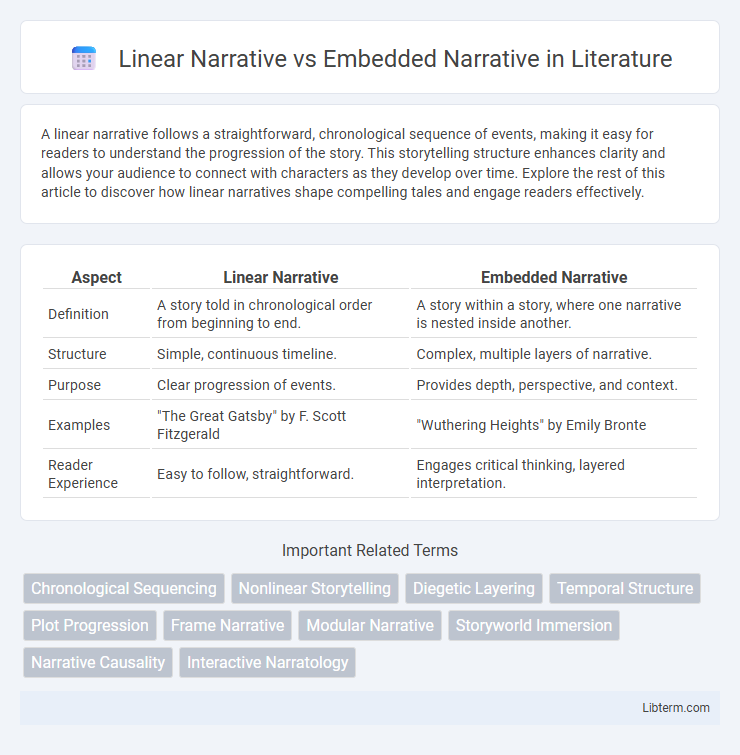A linear narrative follows a straightforward, chronological sequence of events, making it easy for readers to understand the progression of the story. This storytelling structure enhances clarity and allows your audience to connect with characters as they develop over time. Explore the rest of this article to discover how linear narratives shape compelling tales and engage readers effectively.
Table of Comparison
| Aspect | Linear Narrative | Embedded Narrative |
|---|---|---|
| Definition | A story told in chronological order from beginning to end. | A story within a story, where one narrative is nested inside another. |
| Structure | Simple, continuous timeline. | Complex, multiple layers of narrative. |
| Purpose | Clear progression of events. | Provides depth, perspective, and context. |
| Examples | "The Great Gatsby" by F. Scott Fitzgerald | "Wuthering Heights" by Emily Bronte |
| Reader Experience | Easy to follow, straightforward. | Engages critical thinking, layered interpretation. |
Introduction to Narrative Structures
Linear narrative presents events in chronological order, creating a straightforward and easy-to-follow storyline that emphasizes cause-and-effect relationships. Embedded narrative, also known as a framed narrative, contains one or more stories within the main story, offering multiple perspectives and adding depth to the overall plot. Understanding these narrative structures helps writers control pacing, reveal character motivations, and enhance thematic complexity.
Defining Linear Narrative
Linear narrative follows a straightforward, chronological sequence where events progress in a cause-and-effect order. This narrative structure emphasizes a clear beginning, middle, and end, allowing audiences to easily track plot development and character arcs. Linear narratives are commonly found in classical storytelling, ensuring coherence and simplicity in conveying the story.
Understanding Embedded Narrative
Embedded narrative involves a story within a story, where a secondary narrative is nested inside the main plot, providing multiple layers of meaning and perspective. This structure enhances storytelling by offering depth and complexity through the interaction of primary and secondary narratives. Understanding embedded narrative allows appreciation of how authors weave interconnected plots to enrich themes and character development.
Key Differences Between Linear and Embedded Narratives
Linear narratives follow a straightforward chronological sequence, making events easy to track and comprehend, while embedded narratives contain multiple layers of stories within stories, creating a complex structure. Linear narratives prioritize clarity and direct cause-effect relationships, whereas embedded narratives emphasize depth by providing context, backstory, or multiple perspectives. The key difference lies in linear narratives' simplicity and progression versus embedded narratives' intricacy and layered storytelling technique.
Advantages of Linear Narratives
Linear narratives offer a clear and straightforward progression of events, making it easier for audiences to follow the storyline without confusion. This structure enhances emotional engagement by building tension and character development in a sequential flow. The simplicity of linear narratives supports efficient storytelling, ideal for conveying messages directly and maintaining audience attention.
Benefits of Embedded Narratives
Embedded narratives enhance storytelling by providing multiple layers of context, enriching the audience's understanding and engagement. They enable complex character development and thematic depth by intertwining subplots within the main story. This narrative structure allows for greater flexibility in pacing and perspective, offering a more immersive and multifaceted experience.
Common Examples in Literature and Film
Linear narratives, characterized by chronological storytelling, are exemplified in classic literature like Jane Austen's "Pride and Prejudice" and films such as "Forrest Gump." Embedded narratives, which feature stories within stories, appear in works like Mary Shelley's "Frankenstein" and movies like "Inception," where multiple narrative layers intertwine. Both narrative structures enhance thematic depth and audience engagement by manipulating time and perspective in distinct ways.
Impact on Audience Engagement
Linear narratives provide a clear, chronological progression that helps audiences follow the storyline easily, fostering emotional investment through predictable pacing and development. Embedded narratives, with multiple layers or stories within stories, create complex engagement by encouraging viewers to actively piece together relationships and meanings, enhancing cognitive involvement. This complexity often results in deeper immersion, as audiences are compelled to analyze and interpret the interwoven plots, increasing long-term retention and discussion.
Narrative Structure and Storytelling Effectiveness
Linear narrative follows a straightforward chronological sequence, enhancing clarity and audience engagement by allowing easy comprehension of cause and effect events. Embedded narrative incorporates stories within stories, enriching the plot with multiple perspectives and deeper character development, which increases complexity and emotional resonance. The choice between linear and embedded narrative structures significantly impacts storytelling effectiveness by balancing simplicity with layered meaning to suit different narrative goals.
Choosing the Right Narrative Technique
Selecting the right narrative technique depends on the story's complexity and audience engagement goals. Linear narratives offer straightforward storytelling ideal for clear cause-and-effect progression and easy comprehension. Embedded narratives suit multifaceted tales by layering multiple storylines, enriching character development and thematic depth when expertly balanced.
Linear Narrative Infographic

 libterm.com
libterm.com